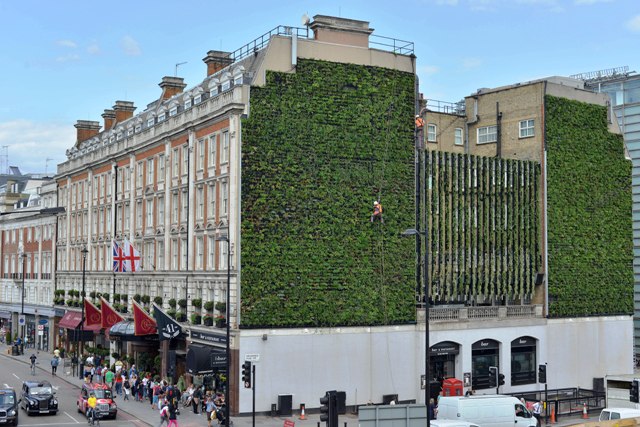Description of the application
London’s Largest Living Wall. The huge green wall covering an entire facade of a hotel, making it the largest wall of vertical plants in London. The permanent feature is located on the exterior wall of the Rubens at the Palace hotel in Victoria. Standing at 350 square metres with over 10,000 ferns, herbaceous plants and 16 tons of soil, the wall reaches over 21 metres high and is packed with over 20 seasonal plant species including buttercups, crocuses, strawberries, spring bulbs and winter geraniums. The flowers have been chosen to ensure the wall is ‘in-bloom’ all year round, attracting wildlife such as birds, butterflies and bees. The wall was designed in 2013 in an attempt to reduce local environmental issues such as surface flooding and air pollution. The wall’s unique design enables it to capture rainwater from the roof of the building in dedicated storage tanks. A key environmental challenge in Victoria is the risk of flooding during periods of heavy rain, due to the low absorbency of urban surfaces. According to the Environment Agency, there are now around 534,000 properties in London on the Thames floodplain, and one in four in London are at risk of flooding.Comments
http://www.dezeen.com/2013/08/21/londons-largest-living-wall-will-combat-flooding/ http://www.greenhotelier.org/our-themes/water/londons-largest-living-wall/Implementation cost
Estimated financial cost for the implementation of the measures, given as a cost range.
Flood management measure
Which flood management measures have been applied? Multiple measures may be specified.
Impact of floods
What is the impact of floods AFTER the measures are implemented? Multiple impacts may be specified.
Country
Country in which the application (case study) is located. In case of a transboundary application multiple countries are specified.
Last modified: Sept. 13, 2016, 3:17 a.m.


 Ελληνικά
Ελληνικά

